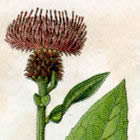
Give me back our nakedness and light
and like the scent of knapweed—
wet, faintly sweet, like an afterthought—
give me the white sky, blushing.
Extract from "Street Without Street Lamps" by Sarah Maclay
Latin name - Centaurea nigra (Black/Lesser Knapweed) Centaurea Scabiosa (Greater Knapweed)
aka -
Black Knapweed, Churls Head, Greater Knapweed, Hardhead, Ironhead, Hard Irons, Lesser Knapweed, Logger Head, Horse Knops, Matte Felon, Mat Fellon, Bottleweed, Bullweed, Cowede, Boltsede
Family - Asteraceae
Parts used - Root, Seed
Purported actions -
adiuretic, diaphoretic, tonic
Methods of use - medicinal
Origins - Knapweed is native to western Europe, it has been introduced to North America where it is considered to be invasive.
Description - The Black Knapweed, is a perennial, with an unwinged, erect stem, 6 inches to 3 feet high, generally freely branched in the upper part. The leaves are very variable, both in breadth and degrees of division, the upper ones narrow and generally with entire margins, but the lower ones lobed, or at any rate with some coarse teeth. The whole plant is dull green, rather rough with small hairs, the stems, like the preceding species, very tough. The flowers are without the spreading outer rays of the Greater Knapweed, the florets being all tubular, which makes the black fringes to the bracts of the involucre most noticeable, hence the name of the species. The florets are of a less bright purple in color.
The Greater Knapweed is also a perennial, the rootstock thick and woody in old plants. The stem is 1 to 3 feet high, generally branched, very tough. The leaves, which are firm in texture, are very variable in the degree of division, but generally deeply cut into, the segments again deeply notched. The lower leaves are very large, often a foot or even more in length, making a striking looking rosette on the ground, from which the flowering stems arise. The whole plant is a dull green, sparingly hairy. It flowers in July and August. The flowers are terminal, somewhat similar to those of the Cornflower in general shape, though larger. All the florets are of the same color, a rich purplish-crimson, the outer ray ones with the limb divided nearly to the base into narrow, strap-shaped segments. The flower-head is hard and solid, a mass of bracts lapping over each other like tiles, each having a central green portion and a black fringe-like edge.
Both species are very common and generally distributed in pastures, borders of fields and roadsides throughout Britain, and flowers from early June till well into September. Species of knapweed may readily be distinguished from thistles by the absence of spines and prickles.
Attributed medicinal qualities - Knapweed was once used as an ointment to heal wounds. It was also used to soothe sore throats and bleeding gums and with pepper for loss of appetite. It is also purported to be good to treat catarrh.
History - Knapweed was in olden times called 'Matte Felon,' from its use in curing felons or whitlows. As early as 1440 we find it called 'Maude Felone,' or 'Boltsede.'
Cultivation - It is common and frequently found in fields and waste places in Britain on chalky soil, but is rare in Scotland. Although considered a weed (hence it's name) knapweed is extremely attractive in garden borders. It needs to be kept firmly under control though.
It is a very valuable plant to bees and also a magnet for many species of butterfly. If conditions are suitable it will germinate and flower at any time of year.
Harvesting, preparation and storage - Leaving the seed heads uncut at the end of flowering provides a feast for garden birds, but you will risk having a garden full of the stuff the following year.
You can dry the roots and store the seeds in a cool dry place.
Other Uses and Interesting Stuff -
- It is often used in dry floral arrangements.
- In Germany, it is the custom for an unmarried person to wear this flower in their buttonhole.
- There is a flower fairy called Greater Knapweed
- In the children's TV programme "The Herbs" Constable Knapweed kept law and order in the garden and was often seen with his notebook out.
- The dried seeds make a great addition to your bird table.
Culpepper tells us: "it is of special use for soreness of throat, swelling of the uvula and jaws, and very good to stay bleeding at the nose and mouth."